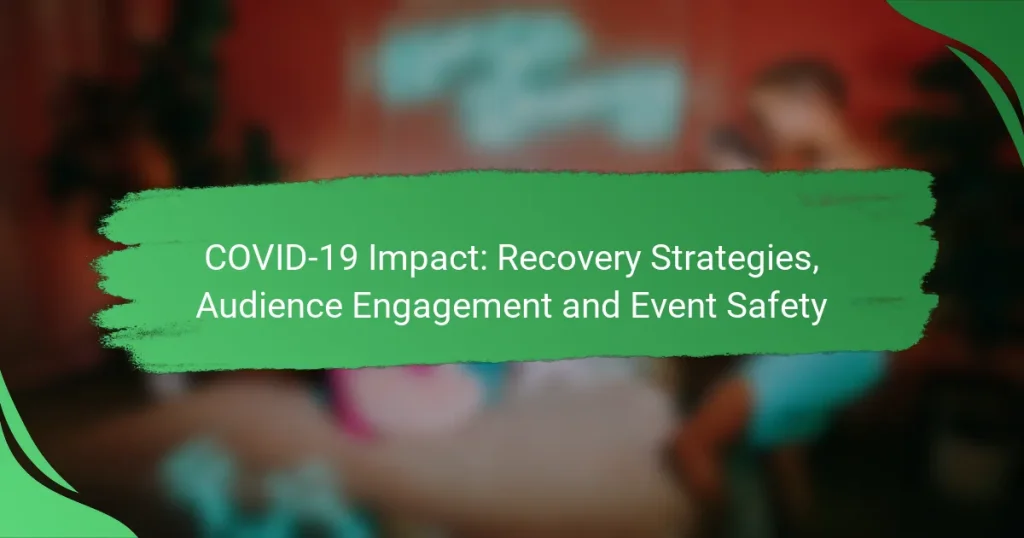The COVID-19 pandemic has significantly altered consumer behaviors, prompting e-commerce businesses to adapt their strategies for recovery. By enhancing digital marketing, improving customer service, and utilizing data analytics, companies can effectively meet the evolving needs of their customers. Additionally, engaging audiences through personalized communication and digital platforms is crucial for rebuilding trust and loyalty. For in-person events, implementing health screenings, sanitation practices, and crowd management is essential to ensure attendee safety and minimize transmission risks.

How can e-commerce businesses recover from COVID-19?
E-commerce businesses can recover from COVID-19 by adapting their strategies to meet changing consumer behaviors and preferences. This involves enhancing digital marketing efforts, improving customer service, and leveraging data analytics to drive informed decisions.
Implementing digital marketing strategies
Digital marketing strategies are essential for e-commerce recovery as they help reach a wider audience and engage existing customers. Consider utilizing social media platforms, email marketing, and search engine optimization (SEO) to increase visibility and drive traffic to your online store.
Focus on creating targeted campaigns that resonate with your audience. For example, personalized email offers or social media ads based on browsing history can significantly boost engagement and conversion rates.
Enhancing online customer service
Improving online customer service is crucial for building trust and loyalty. Implement live chat options or chatbots to provide immediate assistance, ensuring customers feel supported during their shopping experience.
Additionally, train your customer service team to handle inquiries efficiently and empathetically. Quick response times and clear communication can enhance customer satisfaction and encourage repeat purchases.
Adopting flexible return policies
Flexible return policies can significantly impact customer purchasing decisions. Offering extended return windows or free returns can alleviate concerns about online shopping, especially in uncertain times.
Consider clearly communicating these policies on your website and during the checkout process. This transparency can enhance customer confidence and lead to higher sales conversions.
Utilizing data analytics for consumer insights
Data analytics can provide valuable insights into consumer behavior, helping e-commerce businesses make informed decisions. Analyze purchasing patterns, website traffic, and customer feedback to identify trends and preferences.
Utilize tools like Google Analytics or customer relationship management (CRM) software to gather and interpret data. This information can guide marketing strategies, product offerings, and inventory management, ultimately driving sales and improving customer satisfaction.

What audience engagement strategies are effective post-COVID?
Effective audience engagement strategies post-COVID focus on leveraging digital platforms and personalized communication to rebuild connections. These approaches not only enhance interaction but also foster loyalty and trust among audiences that have shifted their preferences during the pandemic.
Leveraging social media platforms
Social media platforms are crucial for engaging audiences in a post-COVID landscape. Brands can utilize platforms like Facebook, Instagram, and Twitter to share updates, promote events, and interact with followers in real-time. Regularly posting engaging content, such as polls or live Q&A sessions, can significantly boost audience participation.
Consider creating targeted ads to reach specific demographics, as many users have increased their online activity. Tailoring content to resonate with current sentiments can enhance engagement rates and foster a sense of community.
Creating personalized email campaigns
Personalized email campaigns can effectively re-engage audiences by delivering tailored content directly to their inboxes. Segment your audience based on preferences or past interactions to ensure that the messages are relevant and timely. Use engaging subject lines and personalized greetings to increase open rates.
Incorporate dynamic content that changes based on user behavior, such as product recommendations or event invitations. This approach can lead to higher conversion rates and a more meaningful connection with your audience.
Hosting virtual events and webinars
Virtual events and webinars have become essential for audience engagement in a post-COVID world. These online gatherings allow for real-time interaction and can attract a global audience without geographical limitations. Consider using platforms like Zoom or Microsoft Teams to host discussions, workshops, or product launches.
To maximize participation, promote your events through social media and email campaigns, and offer incentives such as exclusive content or discounts for attendees. Ensure that the events are interactive by incorporating Q&A sessions or breakout discussions to keep the audience engaged throughout.

What safety measures should be in place for events?
To ensure the safety of attendees at events, several key measures must be implemented. These include health screenings, sanitation practices, and effective crowd management to minimize the risk of COVID-19 transmission.
Implementing health screening protocols
Health screening protocols are essential for identifying potential COVID-19 cases before they enter the event venue. This can involve temperature checks, symptom questionnaires, and, in some cases, rapid testing. It’s advisable to communicate these requirements clearly to attendees prior to the event.
Consider using contactless temperature scanners to streamline the process and reduce wait times. Establishing a designated area for screenings can help maintain order and ensure privacy for individuals being screened.
Ensuring proper sanitation practices
Proper sanitation practices are critical in maintaining a safe environment during events. This includes frequent cleaning of high-touch surfaces, providing hand sanitizers at various locations, and ensuring that restrooms are stocked with soap and disinfectants.
Implementing a cleaning schedule that outlines specific times for sanitizing areas can help keep attendees safe. Additionally, consider using disposable items, such as utensils and napkins, to minimize contact with shared surfaces.
Managing crowd control effectively
Effective crowd control is vital to prevent overcrowding and ensure social distancing at events. This can be achieved by limiting the number of attendees, using ticketing systems that stagger entry times, and clearly marking pathways to guide movement.
Utilizing signage to remind attendees of safety protocols and maintaining a visible staff presence can enhance compliance. Consider employing technology, such as crowd monitoring apps, to track attendance and manage flow in real-time.

How can businesses assess their recovery progress?
Businesses can assess their recovery progress by analyzing key performance indicators and customer insights. This evaluation helps identify areas of improvement and informs strategic adjustments for better outcomes.
Tracking sales performance metrics
Monitoring sales performance metrics is crucial for understanding recovery. Key indicators include total sales volume, average transaction value, and customer acquisition costs. Regularly comparing these metrics to pre-pandemic levels can highlight recovery trends.
Consider using tools like sales dashboards to visualize data over time. Aim for a monthly review to track fluctuations and identify patterns, which can help in making informed decisions about inventory and marketing strategies.
Gathering customer feedback regularly
Regular customer feedback is essential for assessing recovery and improving services. Utilize surveys, social media polls, and direct outreach to gather insights on customer satisfaction and expectations. This feedback can guide product offerings and service enhancements.
Establish a routine for collecting feedback, such as quarterly surveys or post-purchase follow-ups. Aim for a response rate of at least 10-15% to ensure the data is representative. Analyze the feedback to identify common themes and areas needing attention, which can significantly impact customer loyalty and retention.

What are the key criteria for selecting recovery strategies?
Key criteria for selecting recovery strategies include assessing the current market landscape, understanding audience needs, and ensuring safety protocols are in place. These factors help organizations adapt effectively to the ongoing impacts of COVID-19 while maintaining engagement and trust.
Evaluating market trends
Evaluating market trends involves analyzing shifts in consumer behavior, industry demands, and economic conditions post-COVID-19. Organizations should monitor indicators such as changes in spending habits, preferences for virtual versus in-person events, and overall market recovery rates.
Utilize tools like market research reports and social media analytics to gather insights. For example, a rise in online shopping may suggest a need for enhanced digital engagement strategies. Regularly revisiting these trends ensures that recovery strategies remain relevant and effective.
Identifying target audience needs
Identifying target audience needs is crucial for tailoring recovery strategies that resonate with stakeholders. Conduct surveys, focus groups, or interviews to gather feedback on what your audience values most, such as safety measures, flexible options, or specific content types.
Consider segmenting your audience based on demographics or preferences to refine your approach. For instance, younger audiences may prefer virtual events, while older demographics might prioritize in-person experiences with strict safety protocols. This targeted understanding helps in crafting messages and offerings that align with audience expectations.

What technology solutions can enhance event safety?
Technology solutions play a crucial role in enhancing event safety by minimizing physical contact and streamlining management processes. Implementing the right tools can significantly reduce health risks while improving attendee experience.
Using contactless payment systems
Contactless payment systems allow attendees to make transactions without physical interaction, reducing the risk of virus transmission. These systems typically use NFC (Near Field Communication) technology, enabling payments through smartphones or contactless cards.
When choosing a contactless payment solution, consider options like mobile wallets (e.g., Apple Pay, Google Pay) or dedicated payment terminals. Ensure that the system is compatible with your event’s ticketing and registration processes to streamline operations.
Implementing event management software
Event management software can enhance safety by providing tools for registration, ticketing, and attendee tracking. These platforms often include features for health screening, contact tracing, and real-time updates, which are essential in maintaining safety protocols.
Look for software that offers customizable options to fit your event’s specific needs. Popular solutions may include features like virtual check-ins and automated notifications, which can help manage crowd flow and ensure compliance with local health regulations.

How can businesses prepare for future disruptions?
Businesses can prepare for future disruptions by establishing robust contingency plans, enhancing communication strategies, and investing in technology that supports remote operations. These proactive measures enable organizations to respond swiftly and effectively to unexpected challenges.
Developing contingency plans
Contingency plans are essential for mitigating the impact of disruptions. Businesses should identify potential risks, such as natural disasters, pandemics, or supply chain interruptions, and develop strategies to address them. This involves creating clear protocols for communication, resource allocation, and operational adjustments.
A practical approach includes conducting regular risk assessments and scenario planning. For instance, businesses can simulate various disruption scenarios to test their response strategies. This helps to identify weaknesses in the plan and allows for timely adjustments before a crisis occurs.
To ensure effectiveness, involve key stakeholders in the planning process. This can include team leaders, IT specialists, and external partners. Regularly review and update the contingency plans to reflect changes in the business environment or operational capabilities, ensuring they remain relevant and actionable.


